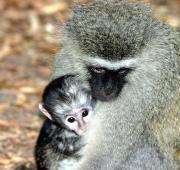 Vervet Monkey Classification and Evolution
Vervet Monkey Classification and Evolution
The Vervet Monkey is a medium to large sized monkey that is primarily found in Eastern Africa. The Vervet Monkey is thought to be a species of Grivet, another tree-dwelling African monkey that has very similar characteristics to the Vervet, along with the Malbrouck which is considered by some to be a sub-species of Vervet Monkey. These three animals are very closely related but they tend to inhabit territories in slightly different locations and are thought to rarely come into contact with one another. There are currently six recognised sub-species of the Vervet Monkey that are generally classified depending on their location, although there is some difference in colouration between them.

The Vervet Monkey grows to an average of 50cm tall, with a tail that is often longer than the body itself and has a black tip. Their fur tends to be grey or olive in colour (depending on the species) and is lighter on their underside. The hands and feet of the Vervet Monkey are black, along with their ears and face which has a white band above it and is also framed by white cheek tufts. The Vervet Monkey has long arms and legs which are about the same length to allow this species to walk on all fours when on the ground with ease, and actually makes them quite speedy when running. Males tend to be larger than females and are easily distinguished by their bright blue testicles.

The Vervet Monkey is found south of the Sahara and is widespread across Eastern Africa. They are also found in parts of southern and western Africa from Uganda to Ghana but their location is generally dependant on the sub-species. The Vervet Monkey inhabits savanna, woodland and forests that tend to be close to water, preferring acacia forests that line rivers and lakes. Vervet Monkeys can also be found in mountainous regions up to 1,300 feet providing that there is an adequate supply of both food and water to sustain the population. They are rarely found in more extreme environments such as deserts and rainforests as these regions simply do not have everything that Vervet Monkeys require to successfully survive.

The Vervet Monkey is an arboreal monkey which means that it spends most of it's time in the safety of the trees. Although they do venture down to the ground in search of both food and water, Vervet Monkeys rarely go further than 450 meters from the trees, which helps to protect them from predators. They are diurnal animals spending the days foraging for food and then rest at night. The Vervet Monkey is a very sociable animal inhabiting territories in troops that can contain between 10 and 50 individuals, depending on the location and how ample the food supply is. These troops are comprised of adult females and their young, with males wandering between different troops to both socialise and mate.
Vervet Monkey Reproduction and Life Cycles
The Vervet Monkey is not usually able to reproduce until they are about five years old, although their age of sexual maturity is known to vary slightly and may be dependent on how much food they have access too. After about 5 and a half months, females give birth to a single infant which is cleaned by it's mother at birth, and clings to her stomach during the first week or so. Vervet Monkey babies quickly develop strong social bonds with other monkeys and are known to begin interacting and playing with them by the time they are a month old. They have pink faces and black fur and don't tend to develop their adult colouration until they are a few months old. Vervet Monkey offspring suckle on their mother's milk until they are nearly four months old and start to eat softer vegetation, but they are not fully weaned until they are about a year old.
Vervet Monkey Diet and Prey The Vervet Monkey
is an omnivorous animal, meaning that they consume both plant matter and other animals in order to get the nutrition that they need to survive. Leaves and young shoots make up the bulk of the Vervet Monkey's diet, along with tree bark, flowers and fruits that can also be found in the trees surrounding them. On the ground Vervet Monkeys forage for roots, bulbs, seeds and grasses and are also known to supplement their diet with insects, eggs, rodents, birds and other small animals. Like many other monkey species, the Vervet uses it's incredibly dexterous hands in order to collect food, with it's long tail aiding in balancing on the tree branches.
Vervet Monkey Predators and Threats
The Vervet Monkey has few predators whilst it remains in the safety of the trees with larger species of Eagle being their most common threat. On the ground however, they are preyed upon by a number of Africa's large predators including felines like the Leopard, Serval and Caracal, along with large reptiles such as Pythons, and Crocodiles close to water. Never venturing too far from the trees means that the Vervet Monkey can quickly make it back up into safety, and it's ability to run at speed allows them to try and escape more quickly. Although Vervet Monkeys generally only make chattering sounds, they are known to scream and whistle to alert other members of the troop that they are in danger.
Vervet Monkey Interesting Facts and Features
Despite the fact that the Vervet Monkey tends to reach sexual maturity after a number of years in the wild, sexual maturity in captivity tends to occur much sooner at an average age of two years old. They are incredibly well adapted to their surrounding environments as they can jump and climb well when in the trees and are pretty speedy on the ground, along with being excellent swimmers. Younger females in the troop that are not yet mature, often show a keen interest in the offspring of adult females and assist them with grooming and caring for their young. They are also known to love to hold them, making it not wonder that social bonds within the troop particularly between relatives, often last for life.
Vervet Monkey Relationship with Humans
The Vervet Monkey has adapted well to the growing urban environments that have replaced it's historical habitat, but they are sometimes seen as pests in these areas. Vervet Monkeys are known to raid fields of crops, along with stealing food and other items that they find and are rarely caught by Humans due to their speed and agility, both on the ground and in the trees. Although they have been affected by growing Human settlements, it is also the destruction of their natural ranges mainly for agriculture, that is affecting the Vervet Monkey populations. They have also been introduced onto two of the West Indian Islands, which are the islands of St. Kitts and Barbados.
Vervet Monkey Conservation Status and Life Today
Today, the Vervet Monkey has been listed as a species that is of Least Concern of becoming extinct in it's natural environment in the immediate future, as the species is widespread and is found in a variety of different habitats. Although they have also adapted well to city-life, they are often killed by electricity pylons and traffic along with being used in traditional medicines, and caught as bushmeat.

